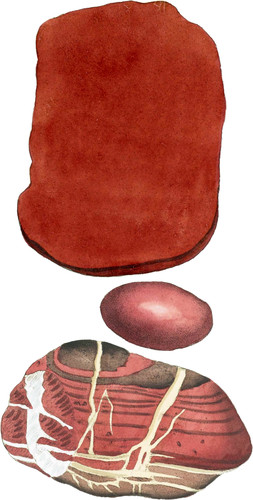 Enlarge
Enlarge
British Mineralogy
Red Jasper
- Class 2. Earths.
- Order 1. Homogeneous.
- Gen. 4. Silex.
- Spec. 1. Quartzum.
- Div. 3. Amorphous.
- Syn.
- Quartz Jaspe rouge. Haüy, 2. 436.
- Gemeiner Jaspis. Emmerl. 1. 243.
- Jasper. Kirwan, 1. 309.
- Silex Jaspis. Linn. Syst. Nat. ed. 13.
Green Jasper, or Ribband Jasper, has been figured at tab. 157, of this work. Bed Jasper is also found striped, veined, &c. The present specimens are, however, the most usual of the red kind in Great Britain. The upper one came from a gravel-pit*, commonly so called, which has a large and curious variety of stones in it, from whence most of the old pavement of the city of York is composed, I am obliged to my kind and indefatigable friend the Rev. J. Dalton for this, and some other very curious specimens from thence, cut and polished ; and it is not a little curious to know that the lapidaries of York have been a long time employed cutting these stones, which they call Marbles†, some of which arc, however, as hard as Oriental stones. The present, like most British specimens, are more porous than the Oriental ones, but in other respects are the same, viz. Quartz mixed with Oxide of Iron and Argill. It is very handsome, and takes a good polish. Stones of the same sorts are found on many of our coasts, but are still more porous, and veined with opaque Quartz, &c. The lower specimen is from Devonshire, sent by my friend G. Montague, Esq. I suspect they fall from near the Serpentine Rocks, and that the red Serpentine may be traced from the softer state to the indurated or harder Serpentine holding Jasper, and may thus have been occasionally confounded with it. Serpentine may generally be scraped with a knife; Jasper, I should think, never: and it is perhaps worthy of observation, that different states of red Serpentine resemble Brick; and some curious persons have picked up these in various states from that resembling soft Brick to Jasper, considering them as Brick passing from the more soft beginning of petrifaction to the more hard and stony.
- * Gravel-pits near London hold only common Quartz and Flint Pebbles of different sizes—see p. 88.
- † Any largish stones, not Gems, are commonly called. Marbles. I think, however, that this name should be confined to such stones as masons can polish without Emery, as the Marble of Italy.

